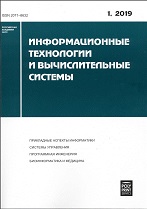|
DATA PROCESSING AND ANALYSIS
Graph analytics for digital economy tasks
D. I. Korovina, E. V. Romanovaa, S. R. Muminovaa, A. V. Osipovb, E. S. Pleshakovac, N. M. Mazutskiya, T. M. Gataullinb, S. T. Gataullinb
a Financial University under the Government of the Russian Federation, Moscow, Russia
b Moscow Technical University of Communications and Informatics, Moscow, Russia
c MIREA–Russian Technological University, Moscow, Russia
Abstract:
The manuscript discusses theoretical and practical examples of the use of graph analytics to solve the priority tasks of the digital economy, as the first stage of the knowledge economy. First, authors outline a simulation model which can be used to track fluctuations in inflation. Since a rise in inflation can reflect the rise in prices of goods and services, and how consumers lose ground as their earnings buy fewer goods, predicting inflation – and its effects – can be of great importance. The model presented is based on the cognitive graph. The cognitive graph has 15 vertices which are factors impacting the economy. The bonds between the vertices are analyzed and the incidence matrix is formed. Next, unbalanced cycles whose length is more than 2 are recognized in the graph. It is these unbalanced cycles that typically cause inflation, and the detriment to the economy. This model makes possible the examination of 5 unbalanced cycles, and its use allows the government (decision-makers) to implement to control and limit inflation’s effects on the economy. The theoretical basis applications of cognitive graphs for the quantitative assessment of knowledge are also presented.
Keywords:
digital economy, knowledge economy, inflation; simulation modeling; cognitive graph; graph analytics; consumer price index; key rate.
Citation:
D. I. Korovin, E. V. Romanova, S. R. Muminova, A. V. Osipov, E. S. Pleshakova, N. M. Mazutskiy, T. M. Gataullin, S. T. Gataullin, “Graph analytics for digital economy tasks”, Informatsionnye Tekhnologii i Vychslitel'nye Sistemy, 2023, no. 3, 33–45
Linking options:
https://www.mathnet.ru/eng/itvs819 https://www.mathnet.ru/eng/itvs/y2023/i3/p33
|

| Statistics & downloads: |
| Abstract page: | 43 | | First page: | 5 |
|




 Contact us:
Contact us: Terms of Use
Terms of Use
 Registration to the website
Registration to the website Logotypes
Logotypes








 Citation in format
Citation in format 